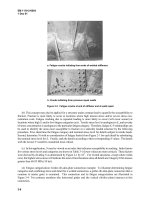Tài liệu Clinical presentation and outcome of patients diagnosed with active pulmonary tuberculosis in a large critical care unit docx
Bạn đang xem bản rút gọn của tài liệu. Xem và tải ngay bản đầy đủ của tài liệu tại đây (703.44 KB, 6 trang )
1
Crit Care & Shock 2011. Vol 14, No. 1
Clinical presentation and outcome of patients diagnosed with active
pulmonary tuberculosis in a large critical care unit
Abdullah A. Alshimemeri, Yaseen M. Arabi, Hamdan Al-Jahdali, Ashwaq Olayan, Othman Al Harbi, Ziad Memish
Crit Care & Shock (2011) 14:1-6
Abstract
Objective: To examine the presentation and outcome of
patients diagnosed with active pulmonary tuberculosis
after admission to the intensive care unit (ICU).
Design: New cases of active pulmonary tuberculosis
admitted to our critical care unit from January 1999
to January 2006 were identied. Data were collected
retrospectively from medical records including
demographics, clinical presentation, number of sputum
samples, therapy provided and patient outcome.
Setting: Data were collected from the ICU database and
microbiology laboratory records.
Patients and participants: Thirty-three patients were
diagnosed with active pulmonary tuberculosis. Age
was 63±17, and 60.7% were males. Onset of symptoms
averaged 17 days prior to presentation (range: 1-90
days), including fever in 51%, cough in 14%, dyspnea in
8%, night sweats in 6%.
Interventions: Twenty-two patients were treated for
tuberculosis during hospitalization. The other 11 were
not diagnosed during hospitalization and were found
later to be culture positive.
Measurements and results: The most common ICU
clinical diagnosis was community-acquired pneumonia
in 54%, followed by aspiration pneumonia in 3%. Out
of 161 tracheal aspirates, only 48 (30%) were AFB stain
positive and 80 (69%) were culture positive. Out of 33
patients who had at least one positive culture, only 62%
were AFB stain positive. Of the 22 patients treated for
tuberculosis during hospitalization; 15 (68%) died.
Of the remaining 11 who were not diagnosed during
hospitalization 7 (64%) died.
Conclusions: Active pulmonary tuberculosis is common
in ICU patients. The diagnosis may be confounded by
atypical clinical presentation and the lack of sensitive
and rapid diagnostic tests. Considering the impact if
misdiagnosis and risk of transmission to health care
professionals, clinicians must maintain high level of
suspicion and a low threshold for respiratory isolation.
Newer and more sensitive tests must be developed and
utilized.
From King Saud Bin Abdulaziz University for Health Sciences, King Abdulaziz Medical City, Riyadh, Saudi Arabia (Abdullah A. Alshimemeri, Yaseen M. Arabi,
Hamdan Al-Jahdali, Ashwaq Olayan, and Othman Al Harbi) and Ministry of Health, Riyadh, Saudi Arabia (Ziad Memish)
Address for correspondence:
Dr. Abdullah Alshimemeri
Associate Professor, Department of Intensive Care Medicine and Dean, Postgraduate Education
King Saud Bin Abdulaziz University for Health Sciences
National Guard Health Affairs
PO Box 22490, Riyadh 11426, Saudi Arabia
Tel: +966-1-2520088 (ext# 13313)
Fax: +966-1-2520072
Email:
Key words: Tuberculosis, ICU, retrospective, misdiagnosis.
Original Article
2
Crit Care & Shock 2011. Vol 14, No. 1
under reporting of severe tuberculosis, factors leading to
admission, and induced toxicities, with resultant diminished
disease awareness. King Fahad National Guard Hospital is
an 800-bed tertiary care hospital located in the central region
of the Kingdom of Saudi Arabia (KSA), provides multilevel
health care for National Guard soldiers and their extended
families. It has one of the largest critical care units in the
Kingdom serve 40 beds and runs by qualied pulmonary
and critical care board certied consultants.
The purpose of our study is to review all cases with active
pulmonary tuberculosis admitted to our intensive care unit
in a period over six years and to examine the characteristics,
presentation, underlying risk factors, outcome of patients
and to highlight the possible causes of delaying diagnosis.
Materials and methods
Here we present a retrospective study that was conducted
to examine the characteristics and outcomes of patients
diagnosed with active pulmonary tuberculosis requiring
ICU admission, and to identify potential factors affecting
mortality rates.
We reviewed the records of patients age of 18 and over
with a diagnosis of severe tuberculosis admitted to the ICU
in our hospital between January 1999 and January 2006.
Patients who had been newly diagnosed with tuberculosis
were retrospectively identied from the ICU database,
medical records and laboratory documents for inclusion in
the study.
Cases of active tuberculosis were dened as positive culture
for Mycobacterium tuberculosis in the sputum, tracheal
aspirate or broncho-alveolar lavage (BAL). We excluded
all patients who are known to have pulmonary tuberculosis
before ICU admission or the cases, which diagnosed on the
bases of clinical judgement only.
Using our standard ICU database, microbiology laboratory
records and other referenced documents, patient related
information and relevant data were collected. Data
collected from medical records included demographics
and characteristics of patients, clinical presentation,
diagnostic procedures employed, test results, reasons for
ICU admission, diagnosis during ICU admission, medical
Introduction
Tuberculosis can be regarded as a global pandemic with
almost 9 million new cases and approximately 2 million
deaths each year. (1) An estimated one-third of the population
of the world is infected with Mycobacterium tuberculosis,
and the resultant disease represents a major public health
problem. (2) Endemic infection is a major contributor to
the annual death rate across the globe. The high morbidity
and mortality of tuberculosis is the source of major medical
and social problems, especially in developing countries.
It is ranked as the seventh highest cause of morbidity
worldwide, and ranks even higher in emerging nations.
(3,4) Since 1993 tuberculosis has been regarded as a global
emergency, and little improvement in the situation has been
seen. Minimal resources coupled with a lack of accurate,
rapid and cost-effective diagnostic tests have posed a major
obstacle to tuberculosis control in nations such as India.
(5) Among South East Asian nations India ranks as one of
the highest in incidence. India possesses one third of the
world’s tuberculosis population, with 1.8 million new cases
per year, excluding 0.2 million cases in which tuberculosis
has developed secondary to HIV. There are two hundred
thousand deaths annually from the disease or related
complications in India. (3,6,7). Saudi Arabia is considered
as an intermediate prevalence area for tuberculosis, probably
because of its level of development. (8,9)
With the help of Revised National Tuberculosis Control
Program (RNTCP) and World Health Organization (WHO)
initiative in terms of Directly Observed Treatment, Short
course (DOTS), efcacious treatment of tuberculosis has
become relatively simple in early cases. (6) On the other
hand, severe fulminating pulmonary tuberculosis remains a
challenge. Tuberculosis required intensive care admission a
count for 1-3% of all tuberculosis cases. (10,11)
Severe tuberculosis triggers respiratory life-threatening
symptoms likely to increase morbidity, and often requires
the transfer of patients to the Intensive Care Unit (ICU).
Respiratory failure is a leading cause of ICU admissions.
Other major causes are adult respiratory distress syndrome
(ARDS), organ failure and dissemination of disease.
Unfortunately treatment in the ICU during the past ve
decades has contributed little to reducing the threat of
these disease entities. (3,6) On the contrary, admission and
treatment in the ICU has produced as a consequence the
3
Crit Care & Shock 2011. Vol 14, No. 1
history, co-morbidities, therapy administered and eventual
outcomes. Data are expressed numerically, with percentages
of groups where applicable. Variations within categories are
shown as means with ranges where appropriate. Comparative
data between characteristics are displayed, and data are
summarized as tables as well as in text.
Results
Patient characteristics
The numbers of patient diagnosed as pulmonary tuberculosis
based on at least one positive sputum culture over period
from January 1999-January 2006 were 33 patients. This
represented a small fraction of the total number of admissions
to the ICU during the six-year period covered by our study.
Within the cohort of 33 patients, 20 (60.7%) were male, and
13 (39.3%) female. The mean age of all patients was 63±17
years.
Clinical presentation
The mean time lapse between onset of symptoms and
presentation at the hospital was 17±SD days, OR average 17
days, ranging from one to 90 days. Symptoms at presentation
were varied. Fever was reported in 51% of patients at the
time of admission. Other symptoms included cough (14%),
dyspnea (8%), night sweats (6%) and fatigue in 21% of
cases. Other less common symptoms, including hemoptysis,
weight loss, severe respiratory insufciency, anemia, and
elevated WBC count. Symptoms were clinically assessed by
the physician present in the ICU at the time of admission.
Symptoms are summarized in Table 1.
Treatment was initiated on the basis of the clinical diagnosis
made during admission to the ICU in 18 (54%) patients.
The initial diagnosis at the time of admission to ICU was
as followings: community-acquired pneumonia 19 patients
(57%), congestive heart failure 4 patients (12%), two patients
had liver failure, and one patient had aspiration pneumonia.
Other diagnoses included severe anemia, pulmonary
embolism, severe ascitis, malignancy, and sepsis. Also three
patients in addition to pulmonary tuberculosis had extra
pulmonary tuberculosis, in form of meningitis, peritonitis
and colitis.
Laboratory/microbiology testing
A total of 161 tracheal aspirates were withdrawn for
microbiological testing from the 33 admitted patients. It
accounted for 5 tracheal aspirate collections per patient at
different time periods. Of the 161 tracheal aspirates 48 (30%)
were stain positive for acid fast bacilli (AFB), eighty were
culture positive aspirates. Among the 33 total patients who had
at least one positive culture, 62% were AFB stain positive.
Patient outcomes
A total of 22 (67%) patients were treated for tuberculosis
during hospitalization based on positive AFB and positive
Mycobacterium tuberculosis. An additional 11 (33%)
patients were diagnosed as tuberculosis based on positive
Mycobacterium culture later on either post discharge from
hospital or post death. A majority of these patients required
mechanical ventilation to assist respiration. Among 22
patients treated for tuberculosis 15 (68%) died during
hospitalization and 7 improved and listed as survivors.
Among the 11 patients who were diagnosed as tuberculosis
at later stage, 7 (64%) died before they received anti
tuberculosis therapy. Outcomes are summarized in Table 2.
Causes of death
In all patients who died, severe tuberculosis and related
complications were the primary cause of death. Seven
patients who later were found to be culture positive died
because of delayed diagnosis multiple organ failure and
septic shock (refractory “severe” tuberculosis).
Discussion
The purpose of this retrospective analysis was to evaluate
the clinical presentation and mortality associated with
patients with tuberculosis who were admitted to the ICU.
The records of a total of 33 patients with tuberculosis
requiring admission to the ICU during a period of six years
were analyzed. The mortality rate among these patients was
high, 22 (67%) of the total. Respiratory failure requiring
mechanical ventilation was the most common cause for
4
Crit Care & Shock 2011. Vol 14, No. 1
mortality.
The mean age of the patients in this analysis was 63 years,
which was somewhat higher than that reported in other
similar studies. In those studies the mean ages were 41
(7) and 59 (12) years. Ranges were from 40 to 80 years,
consistent with published studies. (13) Advanced age was in
general more associated with co-morbid conditions, which
plausibly might be considered the cause of mortality in
cases of tuberculosis. Gender distribution was in line with
data from previous studies (14) as males (60.7%) were seen
more often with severe pulmonary tuberculosis than females
(39.3%). One possible explanation for this disparity might
be the higher exposure of males to droplet infections due to
a greater prevalence of outdoor occupations. Aggravating
factors such as smoking, exposure to air pollutants
and industrial exposure may also predispose males to
tuberculosis.
In our study earlier presentation to the hospital also was
observed in comparison to other studies. While the range
was rather broad, one to 90 days from onset of symptoms
to hospital admission, the mean duration was only
17 days until admission to the ICU. There were fewer
patients with delayed presentation. The mortality rate of
67% might be indicative of an association between early
presentation and mortality. (15) This may well be a logical
conclusion since patients with severe and uncontrolled
symptoms leading to early ICU admission would tend
toward a higher rate of mortality. In a meta-analysis
of the effect of initial drug resistance and treatment
regimen on tuberculosis treatment outcomes from studies
published in English from 1965 to 2007, it was concluded
that treatment outcomes were substantially worse in the
presence of initial drug resistance, which has important
implications in resource-limited settings in which drug
resistance is prevalent. (16) Among the patient cohort in
our study fever was the most common clinical symptom
observed upon presentation to the hospital, and was seen
in one-half (51%) of patients. Fever was indicative of a
high grade of infection that required immediate attention.
Cough, dyspnea and other respiratory symptoms were seen
in approximately 27% of cases, as would be expected in
pulmonary conditions. (17) Hemoptysis was a symptom
of primary concern, although seen in a relatively small
number of patients.
The clinical diagnosis that was the primary contributing
factor to mortality was community-acquired pneumonia,
seen in 54% of cases. This is a predominant condition in
developing countries such as India. (18) A common cause of
pneumonia was nosocomial infection from Streptococcus
pneumonia, requiring mechanical ventilation. It is
probable that debilitating factors such as alcoholism or
anemia are contributory. Aspiration of sputum leading to
aspiration pneumonia was a less common diagnosis in the
study. Similar ndings have been reported in other studies.
(12,19)
Laboratory and microbiological testing were carried out
as conrmatory to the clinical presentation. (20) From a
total of 161 tracheal aspirates, 48 were seen as gram stain
positive for AFB (30%) excluding others as negative.
Cultures were observed to be more sensitive than staining
in 69% of total aspirates, including cases that were found
negative with gram staining. Cultures are more specic in
diagnosing early stage tuberculosis. (21)
Mortality among patients during hospitalization was higher
among treated patients than the non-treated group. Twenty-
two patients with an early diagnosis, admitted to the ICU
and treated had a somewhat higher rate of mortality.
Eleven non-treated patients who were diagnosed later on
with tuberculosis were treated empirically. Seven of them
died. These patients suffered from underlying tuberculosis
but received treatment for pneumonia. This ultimately
resulted in respiratory failure. This result illustrates the
deleterious effect of delayed or missed diagnosis. Delay
in diagnosis is signicant to both disease prognosis at the
individual level and transmission within the community.
This corresponds to previous studies. (22,23) With the
emergence of HIV with tuberculosis co-infection, it is of
primary importance to conduct laboratory evaluations to
rule out life threatening compounding of conditions. (24)
Suppression of the immune system is the basic cause of
HIV-tuberculosis co-infection. In this study there was
no case of HIV-tuberculosis co-infection, despite the
fact that it was conducted in a developing nation. (25)
Major advances that would carry tuberculosis diagnosis
and treatment to a new level have not yet been realized.
While there has been some progress, accelerated advances
are needed. Despite the overwhelming global burden
of tuberculosis and the overall low rates of diagnosis,
5
Crit Care & Shock 2011. Vol 14, No. 1
conventional approaches in general continue to rely on tests
that have major limitations. One of the primary reasons
for this is the lack of a sensitive method for reliable
diagnosis, especially in HIV-positive patients. Clinical
trials will be necessary to identify and demonstrate the
efficacy of new diagnostic methods. These trials must
be conducted in the geographical areas where they will
be used, specifically in developing countries with high
incidences of tuberculosis. (26,27)
The small sample size in this study may possibly have
limited the statistical signicance of some of the ndings.
Also, retrospective analyses such as this are dependent
on available data. This is a major disadvantage in
retrospective study design. A larger prospective study
should be undertaken to conrm these ndings on clinical
presentations and outcomes of patients with active
pulmonary tuberculosis.
Conclusion
In emerging nations infections such as tuberculosis
requiring intensive care are not uncommon. Clinician
awareness of the symptomatology and contributory factors
of the disease is vital. Diagnoses may be challenged by
atypical clinical presentations along with the lack of
sensitive and rapid diagnostic tests. Early diagnosis of
tuberculosis can reduce the health burden and mortality
among an expanded stratum of the population. As was seen
in this study, late or missed diagnoses resulting in non-
treated cases are contributory to unnecessary morbidity
and mortality. It will be important to develop and utilize
novel, more sensitive and specic tests. Considering the
serious impact of missed or delayed diagnoses and the
risk of transmission to health care professionals, clinicians
must maintain a high level of suspicion and a low threshold
for respiratory isolation to combat tuberculosis.
Symptoms %
15 reveF
41 hguoC
8 aenpsyD
6 staews thgiN
Less common symptoms (fatigue, hemoptysis, weight loss, severe respiratory
insufficiency, anemia, elevated WBC)
21
Treatment/Outcome Number of patients (n=33) %
76 22 noitazilatipsoh gnirud BT rof detaerT
Treated according to clinical 33 11 *BT-non sisongaid
86 51 stp detaert BT ,noitazilatipsoh gnirud shtaeD
23 7 stp detaert BT ,srovivruS
46 7 stp detaert BT-non ,shtaeD
Table 1. Symptoms at presentation (33 patients)
Legend: *Found later to be culture positive for TB
Table 2. Patient outcomes
6
Crit Care & Shock 2011. Vol 14, No. 1
References
1. Hall RG, Leff RD, Gumbo T. Treatment of
active pulmonary tuberculosis in adults:
current standards and recent advances.
Insights from the Society of Infectious
Diseases Pharmacists. Pharmacotherapy
2009;29:1468-81.
2. Guy ES, Mallampalli A. Managing TB
in the 21st century: existing and novel
drug therapies. Ther Adv Respir Dis
2008;2:401-8.
3. Agarwal S, Chauhan L. Tuberculosis Control
in India. [Online]. 2005 [cited 2010 Jul 15].
Available from: URL:htttp://www.tbcindia.
org/pdfs/tuberculosis%20control%20in%20
india-nal.pdf.
4. Jeong YJ, Lee KS. Pulmonary tuberculosis:
up-to-date imaging and management. AJR
Am J Roentgenol 2008;191:834-44.
5. Sohn H, Minion J, Albert H, Dheda K, Pai
M. TB diagnostic tests: how do we gure
out their costs? Expert Rev Anti Infect Ther
2009;7:723-33.
6. Chakraborty AK. Epidemiology of
tuberculosis: current status in India. Indian J
Med Res 2004;120:248-76.
7. Mannle C, Wiedemann K, Ruchalla E. The
incidence of tuberculosis at an intensive
care unit. Anasth Intensivther Notfallmed
1989;24:334-40.
8. al-Kassimi FA, Abdullah AK, al-Hajjaj MS,
al-Orainey IO, Bamgboye EA, Chowdhury
MN. Nationwide community survey of
tuberculosis epidemiology in Saudi Arabia.
Tuber Lung Dis 1993;74:254-60.
9. Bener A. Prevalence of tuberculosis infection
in ABHA and BAHA. Eur J Epidemiol
1990;6:376-81.
10. Frame RN, Johnson MC, Eichenhorn MS,
Bower GC, Popovich J Jr. Active tuberculosis
in the medical intensive care unit: a 15-
year retrospective analysis. Crit Care Med
1987;15:1012-4.
11. Erbes R, Oettel K, Raffenberg M, Mauch H,
Schmidt-Ioanas M. Lode H. Characteristics
and outcome of patients with active
pulmonary tuberculosis requiring intensive
care. Eur Respir J 2006;27:1223-8.
12. Zahar JR, Azoulay E, Klement E, De
Lassence A, Lucet JC, Regnier B, et al.
Delayed treatment contributes to mortality in
ICU patients with severe active pulmonary
tuberculosis and acute respiratory failure.
Intensive Care Med 2001;27:513-20.
13. Frame RN, Johnson MC, Eichenhorn MS,
Bower GC, Popovich J Jr. Active tuberculosis
in the medical intensive care unit: a 15-
year retrospective analysis. Crit Care Med
1987;15:1012-4.
14. Erbes R, Oettel K, Raffenberg M, Mauch H,
Schmidt-Ioanas M, Lode H. Characteristics
and outcome of patients with active
pulmonary tuberculosis requiring intensive
care. Eur Respir J 2006;27:1223-8.
15. Rao VK, Iademarco EP, Fraser VJ, Kollef
MH. The impact of comorbidity on
mortality following in-hospital diagnosis of
tuberculosis. Chest 1998;114:1244-52.
16. Lew W, Pai M, Oxlade O, Martin D,
Menzies D. Initial drug resistance and
tuberculosis treatment outcomes: systematic
review and meta-analysis. Ann Intern Med
2008;149:123-34.
17. Penner C, Roberts D, Kunimoto D, Manfreda
J, Long R. Tuberculosis as a primary cause
of respiratory failure requiring mechanical
ventilation. Am J Respir Crit Care Med
1995;151:867-72.
18. Silva DR, Menegotto DM, Schulz LF,
Gazzana MB, Dalcin PT. Mortality among
patients with tuberculosis requiring intensive
care: a retrospective cohort study. BMC
Infect Dis 2010,10:54.
19. Marrie TJ. Community-acquired pneumonia.
Clin Infect Dis 1994;18:501-13.
20. Sharma SK, Mohan A, Pande JN, Prasad KL,
Gupta AK, Khilnani GC. Clinical prole,
laboratory characteristics and outcome in
miliary tuberculosis. QJM 1995;88:29-37.
21. Morell-Ducos F. Is the time taken for sputum
cultures to become negative in multidrug-
resistant TB related to treatment outcome?
Thorax 2006;61:670.
22. Storla DG, Yimer S, Bjune GA. A systematic
review of delay in the diagnosis and
treatment of tuberculosis. BMC Public
Health 2008;8:15.
23. Sreeramareddy CT, Panduru KV, Menten J,
Van den Ende J. Time delays in diagnosis of
pulmonary tuberculosis: a systematic review
of literature. BMC Infect Dis 2009;9:91.
24. Jones BE, Young SM, Antoniskis D, Davidson
PT, Kramer F, Barnes PF. Relationship
of the manifestations of tuberculosis to
CD4 cell counts in patients with human
immunodeciency virus infection. Am Rev
Respir Dis 1993;148:1292-7.
25. Zaidi AK, Awasthi S, deSilva HJ. Burden
of infectious diseases in South Asia. BMJ
2004;328:811-5.
26. Nahid P, Pai M, Hopewell PC. Advances in
the diagnosis and treatment of tuberculosis.
Proc Am Thorac Soc 2006;3:103-10.
27. Dubrous P, Alaoui H, N’Dounga Mikolo
B, Koeck JL. Diagnosis of tuberculosis in
developing countries: new perspectives.
Med Trop (Mars) 2009;69:618-28.









